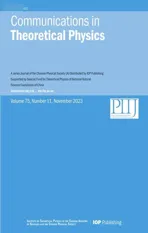Thick accretion disk configurations around a compact object in the brane-world scenario
2023-12-06YunzhuWeiSongbaiChenandJiliangJing
Yunzhu Wei ,Songbai Chen,2,* and Jiliang Jing,2
1 Department of Physics,Key Laboratory of Low Dimensional Quantum Structures and Quantum Control of Ministry of Education,Institute of Interdisciplinary Studies,Synergetic Innovation Center for Quantum Effects and Applications,Hunan Normal University,Changsha,Hunan 410081,China
2 Center for Gravitation and Cosmology,College of Physical Science and Technology,Yangzhou University,Yangzhou 225009,China
Abstract We have studied the equipotential surfaces of a thick accretion disk around a Casadio–Fabbri–Mazzacurati compact object in the brane-world scenario,which possesses a mass parameter together with a parameterized post-Newtonian (PPN) parameter.With the increase in the PPN parameter,the size of the thick accretion disk decreases,but the corresponding Roche lobe size increases.Thus,the larger PPN parameter yields the larger region of existing bound disk structures,where the fluid is not accreted into the central wormhole.Moreover,with the increase in the PPN parameter,the position of the Roche lobe gradually moves away from the central compact object,and the thickness of the region enclosed by the Roche lobe decreases near the compact object but increases in the region far from the compact object.Our results also show that the pressure gradient in the disk decreases with the PPN parameter.These effects of the PPN parameter on the thick accretion disk could help one to further understand compact objects in the braneworld scenario.
Keywords: black hole,brane world,wormhole
1.Introduction
A compact object at the center of the Galaxy should possess an accretion disk,in which matter flows spirally into the central celestial body while simultaneously dropping off its initial angular momenta outwards as well as releasing its gravitational potential energy into heat.The analyses of the properties of accretion disks can disclose the motion of matter near the central celestial body,which could offer the opportunity to capture some information from the celestial body because the accretion occurs in the strong gravity region.Therefore,the studies of accretion disks have contributed to the examination of the predictions from various theories of gravity,including general relativity,which may deepen the understanding of the gravitational interaction [1–19].Generally,in terms of their geometrical thickness,accretion disk models can be classified into two types.The first is the socalled geometrically thin model,in which the disk height is much smaller than the characteristic radius of the disk [1–3].The heat generated by stress and dynamic friction in the disk can be effectively dispersed through the radiation over its surface,which leads to the fact that the disk is cool.The other type is the geometrically thick model [4–10],in which the energy conversion into radiation is inefficient and the temperature of the accretion gas is higher than that in the previous thin-disk model.It is widely believed that thick accretion disks exist in the vicinity of many x-ray binaries and active galactic nuclei.
In real astrophysical systems,matter accretion is a highly complicated dynamic process and its complete description must resort to highly precise numerical calculations,such as general relativistic magnetohydrodynamics simulations.However,in the past few decades,a simple and analytical model of geometrically thick and stationary tori orbiting black holes,known as Polish doughnuts [10],has attracted considerable attention.Although the matter in this model is assumed to be in equilibrium and is not actually accreted by the black hole,the configurations of these geometrically thick equilibrium tori carry a lot of important characteristic information on the spacetime in the strong field regions.Moreover,due to the fluid being in equilibrium,Polish doughnuts are often used as an initial condition for numerical simulations of accretion flows.Thus,the equilibrium tori around black holes have been studied in spacetimes in general relativity and in other alternative theories of gravity (for a review see e.g.[11–13]).Recently,thick accretion disks have been investigated in the background of the spherically symmetric black hole in Born–Infeld teleparallel gravity [20] and probe effects of the teleparallel parameter on the equilibrium tori around the black hole,which show that the size of the disk monotonically decreases with the teleparallel parameter[21].The non-selfgravitating equilibrium tori have also been studied in the background of the parameterized Rezzolla–Zhidenko black hole [22].It is found that standard ‘singletorus’ and non-standard ‘double-tori’ solutions exist within the allowed space of parameters,which means that the parameterized Rezzolla–Zhidenko black hole possesses a much richer class of equilibrium tori.Moreover,the magnetized accretion disks around Kerr black holes with scalar hair have been respectively studied with constant angular momentum [23] and non-constant angular momentum [24],which could help further constrain the no-hair hypothesis by combining with future observations.Stationary and geometrically thick tori with constant angular momentum have been researched in the background of a non-rotating black hole in f (R)-gravity with a Yukawa-like modification to the Newtonian potential [25].Making a comparison with the Kerr black hole in general relativity,it is easy to find that there are notable changes in the configurations of the disks.Moreover,the equilibrium solutions of magnetized geometrically thick accretion disks have also been studied with non-constant specific angular momentum distribution in the Kerr black hole spacetime [26].
Here,we focus on thick accretion disk configurations around a compact object in the brane-world theory.According to the brane-world scenario [27,28],the usual fourdimensional spacetime might be a three-brane embedded in a five-dimensional spacetime (the bulk).All of the matter fields,including electromagnetic fields,are confined to the threebrane,and only gravity can freely propagate in both brane and bulk.High-energy corrections and Weyl stresses from bulk gravitons mean that a static black hole solution on the brane is no longer the Schwarzschild solution [29].However,the Einstein field equations in five dimensions are found to admit more spherically symmetric solutions on the brane than in four-dimensional general relativity.The first black hole solution on the brane,obtained in [29],has the same form as the usual Reissner–Nordström solution,in which a tidal Weyl parameter plays the role of the electric charge.The star solution with a constant density interior has been studied on the brane [30].The black hole solutions in the brane-world model and the corresponding observable effects have also been widely studied [31–40].The properties of thin accretion disks around a brane-world black hole have been investigated[41],and it is shown that the particular signatures that appeared in the electromagnetic spectrum could offer the possibility to directly test physical models with extra dimension using astrophysical observations from accretion disks.Here,we consider a spherically symmetric solution in the brane world obtained by Casadio,Fabbri and Mazzacurati[42].The properties of thin accretion disks around the Casadio–Fabbri–Mazzacurati (CFM) compact object have also been studied in [41].However,the thick accretion disk configurations around the CFM compact object remain open.The main purpose of this paper is to probe the properties of thick accretion disk configurations around the CFM wormhole.Actually,Casadio,Fabbri and Mazzacurati [42]obtained two analytical solutions of the spherically symmetric vacuum brane world,which are parameterized by the Arnowitt–Deser–Misner (ADM) mass and the parameterized post-Newtonian (PPN) parameters.The first solution is given byandwhere β is a PPN parameter.After a careful analysis,one can find that the PPN parameter β does not affect the thick accretion disk configurations because the potential W (which determines the equipotential surface topology of the disk) does not depend on the metric component grr.This means that the thick accretion disk configurations are the same as in the usual Schwarzschild black hole spacetime.Therefore,here we only consider the second CFM brane-world solution and study the effects of the PPN parameter on the configurations of the thick accretion disk.
The paper is organized as follows.In section 2,we will briefly review the second CFM brane-world solution [42] and then analyze the changes in the marginally stable orbit and the marginally bound orbit with the PPN parameter for a timelike particle.In section 3,we will investigate thick accretion disk configurations around the CFM brane-world compact object and the probe effects of the PPN parameter on the disk configurations.Finally,we present a summary.
2.Particle motions in the background of a compact object in the brane-world scenario
Lets us now briefly review the second CFM brane-world solution in [42] and its metric form is
which is spherically symmetric since it is invariant under a rotation or reflection transformation.The solution is asymptotically flat and possesses an ADM mass parameter M and a PPN parameter γ.However,the geometric properties of the spacetime (1) depend on the value of γ.As γ=1,it reduces to the usual Schwarzschild black hole spacetime and the event horizon is located at r=2M.As γ >1,one can find that the only singularity in the metric lies at r=r0=2Mγ,where all the curvature invariants are regular.Moreover,r=r0is a turning point for all physical curves.Thus,the metric (1) describes the geometry of a wormhole with a throat radius rthroat=2Mγ in this case.As γ <1,the metric is singular at r0and,at the null surface,r=rs=2M/(2 -γ).Along this null surface,the Ricci scalar R diverges asR~1Specifcially,the metric (1) describes the geometry of a naked singularity with a singular null surface rs=2M/(2 -γ).Therefore,the value of γ plays a key role in the global causal structure of the spacetime (1).The analyses of the structure spacetime show that the solution (1)describes the geometry of a pathological naked singularity as γ <1,or a black hole as γ=1,or a regular wormhole as γ >1 [42,43].As in [16],to visualize the spacetime (1),we present the embedding diagrams in figure 1,where the equatorial slice θ=π/2 at a fixed moment in time t=constant is embedded into three-dimensional Euclidean space ds2=dz2+dr2+r2dφ2withdz=
To study the thick accretion disk configurations in the background of a compact object in the brane-world scenario(1),one must obtain the radius of the marginally stable orbit rmsand the marginally bound orbit rmbfor a single time-like particle moving in the spacetime,which are two essential quantities for determining thick disk configurations around a compact object.For the spacetime (1),the Lagrangian density of a single time-like particle’s motion
does not contain the time coordinate t and the angular coordinate φ,so there are two conserved quantities E and L for the particle,which respectively correspond to its energy and angular momentum.With these conserved quantities,the motion equation of the time-like particle moving in the equatorial plane can be further expressed as
with the effective potential
From the conditions of circular orbit Veff=E2andV0′eff=[21,44,45],one can obtain that
Combining E and L in equation (5) with the condition V″eff(r)=0,one can find that
which gives the radius of the marginally stable orbit
The marginally bound orbit rmbis the innermost unstable circular orbit for a time-like particle [21,44,45],which can be determined by Veff=1 andV′eff=0,i.e.
Solving the above equation,we obtain the radius of the marginally bound orbit the azimuthal direction.With these assumptions,the fourvelocity and stress-energy tensor of the perfect fluid can be Figure 2 shows that both the marginally stable orbit radius rmsand the marginally bound orbit radius rmbincrease with the PPN parameter γ of the CFM brane-world compact object.We also present the sizes of the singularity rsand the throat rthroatfor different γ,and show that the marginally stable orbit and the marginally bound orbit are outside the naked singularity as γ <1 or the wormhole throat as γ >1.From equation (5),one can find that the specific angular momentum and energy l for the particle moving along the circular orbit with the radius r can be expressed as
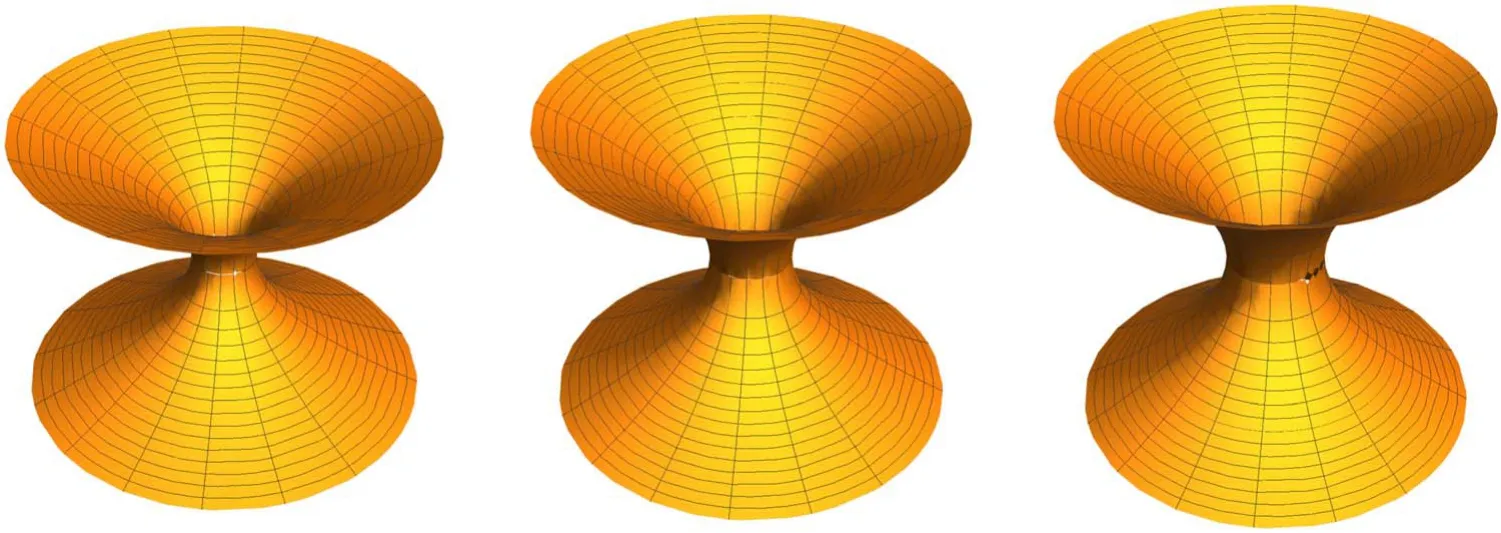
Figure 1.The embedding diagrams of the metric (1).The left,middle and right panels correspond to γ=0.8,1 and 1.2,respectively.Here,we set M=1.
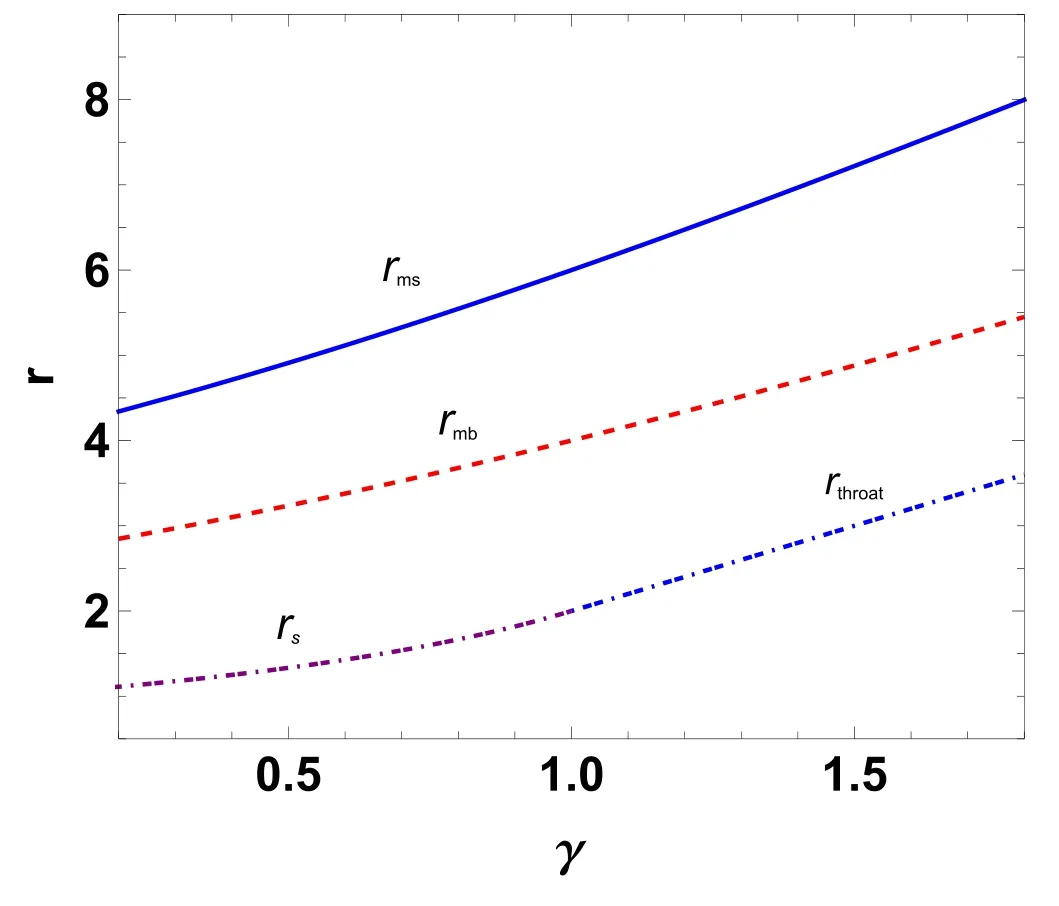
Figure 2.Changes in the marginally stable orbit radius rms and the marginally bound orbit radius rmb with the PPN parameter γ.The blue line and the dashed red line denote the radii rms and rmb,respectively.The purple dot–dash line corresponds to the position of the naked singularity rs,and the blue dot–dash line is the throat radius rthroat.Here,we set M=1.

Figure 3.Changes in the specific angular momentum l2 with the circular orbit radius r for different PPN parameters γ.In the left panel,the blue and red dots indicate the values of and,respectively.In the right panel,the blue line and the dashed red line correspond to the values of l2at the marginally stable orbit rms and the marginally bound orbit rmb,respectively.Here,we set M=1.
The above equations govern the particle motion.From figure 3,one can find that the specific angular momentum for the particle moving along a circular orbit increases with the spacetime parameter γ.Moreover,we also find that l2(rmb) >l2(rms) for each value of γ.
3.Thick accretion disk configurations around the brane-world compact object
Let us now study thick accretion disk configurations around the CFM brane-world compact object (1).As in previous works [4–10,21–26],here we adopt the test-fluid approximation,where the accretion flow in the disk is a barotropic perfect fluid with positive pressure and its self-gravity is negligible so that the influence of the disk on the background spacetime is negligible.We also consider that the fluid is axisymmetric and stationary,which means that the physical variables only depend on the coordinated r and θ.Finally,we assume that the rotation of perfect fluid is restricted to be in expressed as [46]
where ∈and p are the total energy density and the pressure for a comoving observer,respectively.The corresponding redshift factor in the static spacetime (1) can be given by
where l is the specific angular momentum.From the conservation for the perfect fulid∇νTνμ=0,one can obtain [46]
where Ω ≡uφ/utis the angular velocity of the fluid.The specific angular momentum l depends on the circular orbit radius of the particle motion,and the covariant derivative ∇μl describes the changes in the specific angular momentum l for particles moving along two adjacent circular orbits in the fluid.For a barotropic fluid,∈is a function of p;therefore,the right-hand side of (14) becomes a differential.This implies that either dl=0 or Ω=Ω(l).This result is known as the(relativistic) von Zeipel theorem.For a barotropic fluid,one can obtain a solution of the above equation by integration,i.e.
The subscript ‘in’ denotes that the quantity is evaluated at the inner edge of the disk.The potential W determines the topologies of equipotential surfaces on the disk.Therefore,once the expression Ω=Ω(l) is given,one can obtain the equipotential surfaces on the disk.However,in real astrophysical situations,l would be given by certain dissipative processes with timescales much longer than the dynamical timescale,such as the possible viscosity.It must be pointed out that the viscosity in astrophysical accretion disks cannot come from ordinary molecular viscosity,since such ordinary viscosity is too weak to explain the observed phenomena.To date,these dissipative processes are not yet fully understood.A possible alternative way of prescribing this unknown dissipative process is to directly set the angular momentum l in the model as a constant [46] or a non-constant angular momentum distribution [47,48].Here,we adopt the model with the constant distribution of angular momentum l=l0to study the equilibrium configurations in the thick disk for different parameters in the CFM brane-world compact object(1).In this model,the potential W can be further simplified as
The thick disk configurations depend heavily on the specific angular momentum l0.From figure 3,one can obtain that there is a minimum lmsfor the specific angular momentum l0;therefore,the fluid with l0<lmscannot move along a circular orbit and it is not possible for a disk to exist around a CFM brane-world compact object in this case.When l0=lms,only a ring exists around the compact object.As lms<l0<lmb,bound disk structures with a cusp are found to exist.As l0increases to l0=lmb,one can find that the cusp is located at the marginally closed surface that just extends to infinity [21–26].As l0further increases to l0>lmb,one can find that the disk still exists,but not the cusp.
To probe the dependence of the disk configurations on the spacetime parameter γ,we setl0=(lms+lmb),and ensure lms<l0<lmb.By combining equations (1) with (13)and (16),one can obtain the potential function W and probe the properties of the corresponding equipotential surfaces for different γ.Figure 4 shows the disk configurations around a CFM brane-world compact object (1).In each panel,the blue lines denote possible bound disk structures in which there are no actual accretions and the fluid only rotates around the compact object.The red line corresponds to the equipotential surface with a cusp located at the marginally closed surface,which plays the same role as a Roche lobe,and the matter from a disk outside this surface will flow over the cusp and accrete into the central compact object.The purple lines denote bound structures without an inner edge but with a marginally outer edge,and the black lines denote the cases with open surfaces.The closed equipotential surface at an infinite distance satisfies W=0.With the increase in the parameter γ,we find that the value W of the equipotential surface corresponding to the Roche lobe increases,and the surface of the Roche lobe gradually moves away from the central wormhole.The latter can be explained by the fact that both the marginally stable orbit radius rmsand the marginally bound orbit radius rmbincrease with the parameter γ of the brane-world compact object (1).Moreover,with the increase in γ,the thickness of the region enclosed by the Roche lobe decreases near the compact object and increases for the region far from the compact object,but the area of the total region enclosed by the Roche lobe increases,as shown in figure 5,which means that the region of existing bound disk structures without accretion increases with γ.In figure 5,we also find that the cusp is the point nearest the center of the compact object in the Roche lobe.In table (1),we compare the radial coordinate of this cusp rcuspwith the size of the compact object and find that the Roche lobe is outside the compact object.Figure 6 presents the equipotential surface with W=-0.01 outside the Roche lobe for different γ,where the matter filling in this region can be accreted into the central compact object.It is illustrated that the size of the accretion disk decreases with the PPN parameter of the CFM brane-world compact object,which means that the size of the accretion disk for the CFM brane-world wormhole is less than that for the CFM brane-world naked singularity.

Table 1.A comparison between the cusp (the nearest point to the center of the compact object in the Roche lobe) and the size of the compact object for different γ.

Figure 4.Equipotential surfaces for different choices of γ and constant l0=(lmb+lms)/2.The red line indicates the torus with a cuspcorresponding to the maximum of W on the equatorial plane.The blue lines indicate closed tori,the purple lines indicate bound structures without an inner edge and the black lines indicate open surfaces.
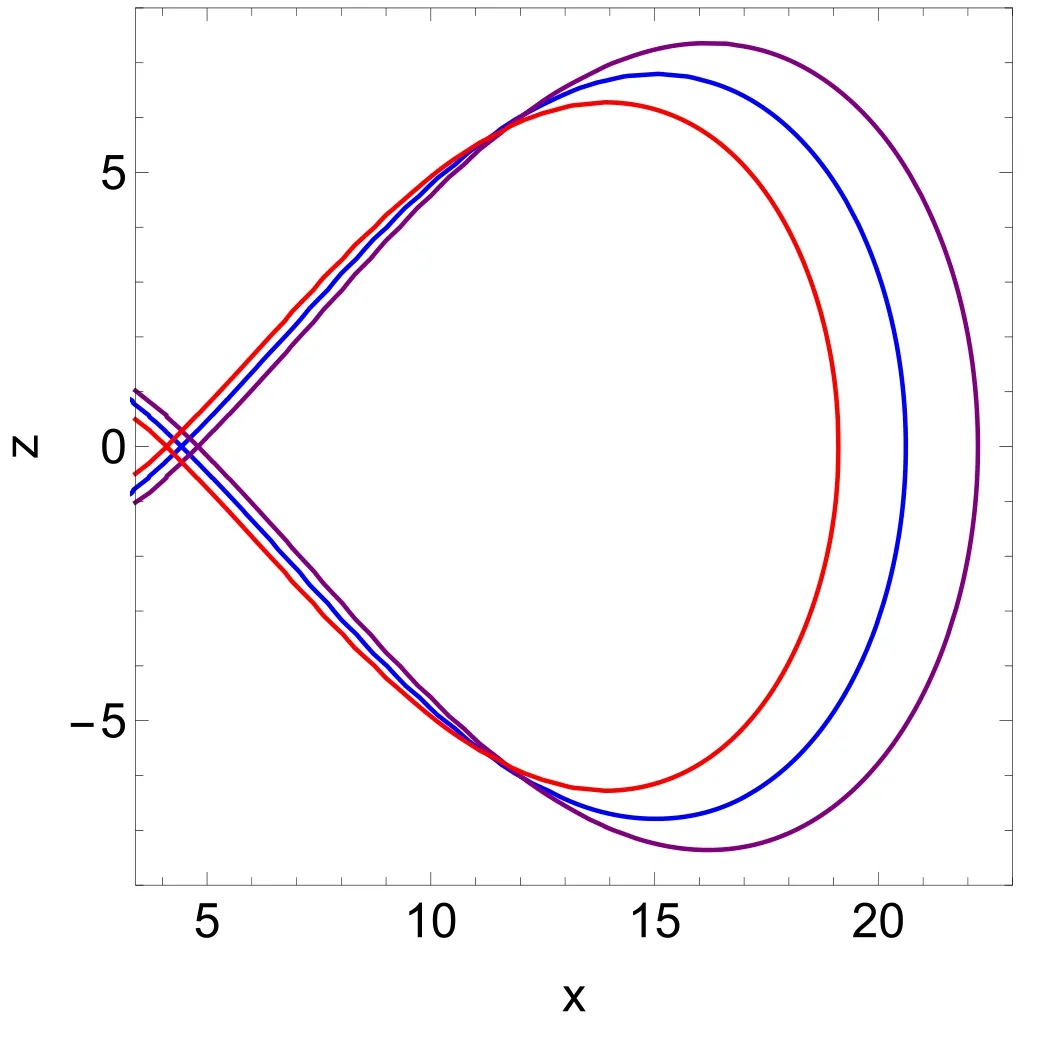
Figure 5.Equipotential surfaces corresponding to the Roche lobe for different choices of γ and constant l0=(lmb+lms)/2.The red,blue and purple lines denote the cases with γ=0.8,1.0 and 1.2,respectively.
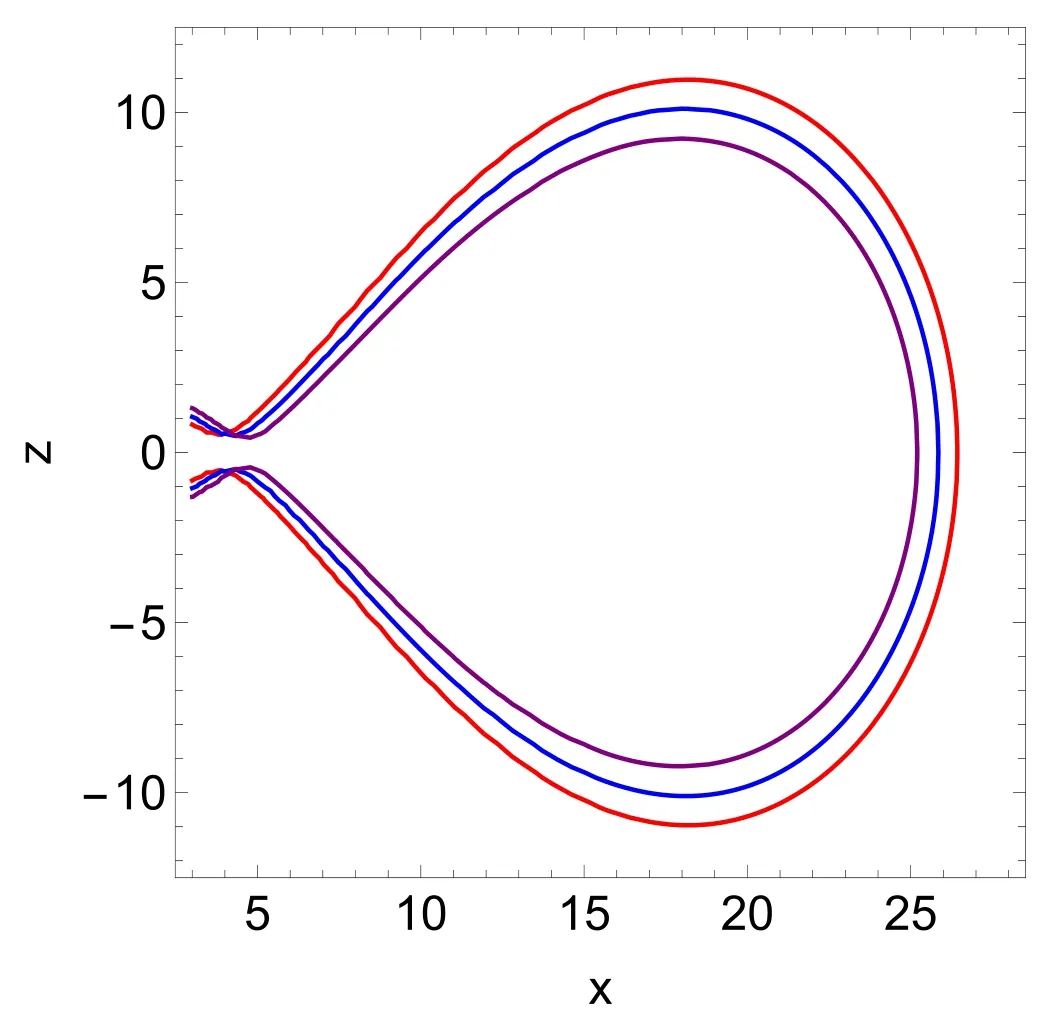
Figure 6.Equipotential surfaces with W=-0.01 outside the Roche lobe for different choices of γ and constant l0=(lmb+lms)/2.The red,blue and purple lines denote the cases with γ=0.8,1.0 and 1.2,respectively.
The pressure gradient in the thick disk is very important for the fluid to maintain balance with gravitational and centrifugal forces [22–26].Since the pressure gradient is related to the difference δW between different equipotential surfaces,we plot the maximal difference δW between the potential values at the cusp and the center of the disk.Figure 7 illustrates that the different δW and the pressure gradient in the equilibrium thick torus decrease with the PPN parameter γ in the CFM brane-world compact object(1).It is also shown that the pressure gradient in the disk is larger in the CFM brane-world naked singularity,and is smaller in the CFM brane-world wormhole case.These results could help one to further understand compact objects in the brane world.
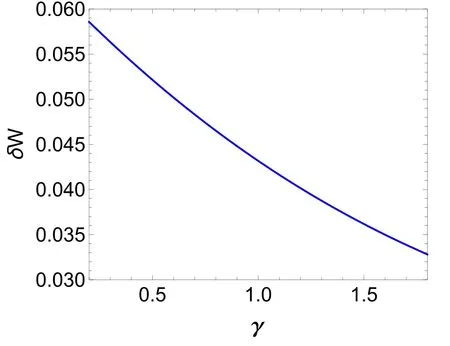
Figure 7.The change in δW with the PPN parameter γ for the braneworld compact object (1) for l0=lmb.
4.Summary
We have studied the equipotential surfaces in the thick accretion disk around the CFM brane-world compact object with a PPN parameter.It is shown that with the increase in the PPN parameter,the size of the thick accretion disk decreases,but the Roche lobe increases.This implies that the larger PPN parameter results in a larger region of existing bound disk structures in which the fluid is not accreted into the central wormhole.Moreover,with the increase in the parameter γ,the surface of the Roche lobe increases,and the Roche lobe gradually moves away from the central compact object.This can be explained by the fact that both the marginally stable orbit radius rmsand the marginally bound orbit radius rmbincrease with the parameter γ.In addition,the thickness of the region enclosed by the Roche lobe decreases with the parameter γ near the compact object,but increases in the region far from the compact object.Finally,we have also studied the different δW between the potential values at the cusp and the center of the disk,which shows that the pressure gradient in the equilibrium thick torus in the CFM brane-world compact object (1) decreases with the parameter γ.Thus,the pressure gradient in the disk in the background of the CFM braneworld compact object is larger than that in the Schwarzschild background when γ <1,but is smaller when γ >1.These results could help one to understand the CFM brane-world compact object and its thick accretion disk.
Acknowledgments
This work was supported by the National Natural Science Foundation of China under Grant Nos.12275078,11875026,12035005 and 2020YFC2201400.
杂志排行
Communications in Theoretical Physics的其它文章
- Vibrational resonance in a multistable system with position-dependent mass
- Study of the gluonic quartic gauge couplings at muon colliders
- AC magnetic trap for cold paramagnetic molecules
- Nonequilibrium kinetics effects in Richtmyer–Meshkov instability and reshock processes
- Insight into the magnetic behavior and magnetocaloric effect of a borophene monolayer
- Graphical representations and worm algorithms for the O(N) spin model
